Rhinology / Sinus Surgery Centre
Rhinology involves study of the nose and sinuses. Common conditions affecting this area are-
1.Sinusitis
What are sinuses?
Sinuses are hollow cavities around the nose. These sinuses open into the nasal cavity. There is continuous formation of mucous from these sinuses which drains into the nose via these openings. These openings can be blocked due to the swelling of the nasal mucosa, as happens frequently in allergies.
What are the symptoms of Sinus Problems?
- Runny nose
- Nasal discharge- that can be green, yellow or occasionally blood stained
- Nasal stuffiness or congestion
- Facial pain or pressure
- Headache
- Sleep disturbances
- Loss of smell
- Fever
How do we treat Sinusitis?
1. Acute Sinusitis
Acute infection of the paranasal sinuses is treated primarily with antibiotics, nasal saline wash, nasal steroid spray and nasal decongestants.What is Nasal Wash?
Just like we brush our teeth nasal wash helps to clean the nose and sinuses.
At Dr Chitale ENT Hospital, Dr Vinaya Chitale has developed a cost-effecive dispenser for patients to facilitate nasal wash.
Advantages of Nasal Wash
- Reduces swelling of the nasal mucosa
- Washes out the secretions and mucous
- Washes out the nose and sinuses
- Facilitates the action of the nasal steroid spray
- Facilitates normal mucociliary function
All the patients are taught how to use the dispenser and do nasal wash properly by our trained staff.
Nasal Wash Dispenser
2. Chronis Sinusitis
Chronic sinusitis is treated with antibiotics, nasal wash and nasal steroid sprays. Chronic sinusitis not responding to medication may require FESS.
What is FESS? (Functional Endoscopic Sinus Surgery)

Para-nasal Sinuses
Functional Endoscopic Sinus Surgery (FESS) is a surgical procedure performed by using endoscopes though the nostrils to avoid any external incisions. Endoscopes are thin, rigid tubes that give a close-up and magnified view of the nasal cavities. This helps the surgeon to find the problem and correct it surgically. Aim of this operation is to open the sinuses to facilitate better drainage of mucous secretions and to ensure adequate aeration of sinus.
Common indications for Functional Endoscopic Sinus Surgery include--
- 1) Nasal Polyposis
- 2) Chronic Sinusitis not responding to medical treatment
- 3) Recurrent sinusitis >4-6 a hours in 6 months
- 4) CSF leak closure
- 5) Excision of selected tumors
- 6) Optic nerve decompression
We perform Functional Endoscopic sinus surgery (FESS) for our patients using state of the art equipment. This includes Medtronic powered instruments such as XPS 3000 console and straight shot M4 hand piece microdebrider. Karl Storz fiber optic nasal endoscopes ( 0 ̊, 30 ̊, 45 ̊), Storz camera system as well as specialized instruments by V. Muller for complicated surgery involving frontal and sphenoid sinus. Typically the patient can be discharged have the same day in a few hours with minimal pain and discomfort. We do not pack the nose after sinus surgery unless patient develops excessive bleeding
Some patients may require additional surgery to correct their problems like deviated nasal septum, enlarged turbinates that can be performed in same setting.

Medtronic XPS 3000 micro-debrider console
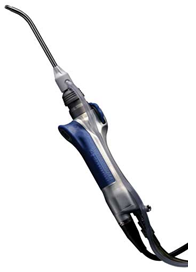
Medtronic straightshot M4 handpiece
2.Deviated nasal septum (DNS)
DNS causing obstruction to airflow through the nose needs surgical correction. We perform a surgery called septoplasty to straighten the septum only if topical nasal sprays have failed to improve nasal congestion. The incisions for this surgery are placed inside the nose. The deviated part of the septum is removed, reshaped or set in the right position. This improves the airway and relieves the patients symptoms. This surgery does not affect the external appearance of the nose. The patient is typically discharged on the same day of surgery with minimal discomfort. We do not pack the nose after surgery. We only use splints to support the septum for 8-10 days
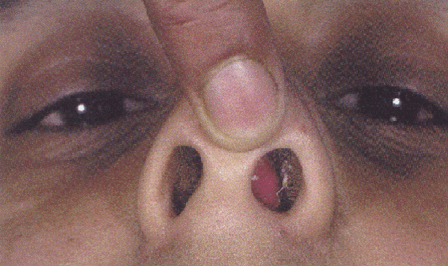
Deviated nasal septum
3. Nasal polyps
Polyps are grape like masses which form in the nasal cavity due to irritation of nasal mucosa. Polyps can obstruct the passage for air through the nasal cavity. They can also obstruct the drainage of sinuses. Non obstructing polyps can be managed with medical treatment but obstructing polyps can be addressed with FESS.
4. Inferior Turbinate Hypertrophy
Turbinates are shelf like projections along the sides of nasal cavities. Sometimes they develop swelling (hypertrophy) and can cause obstruction to the air flow. Turbinate reduction surgery makes the turbinates smaller. We perform Inferior turbinate coblation at our hospital routinely for such patients. It is a quick procedure done with minimum discomfort to the patient using only local anesthesia. The turbinates are reduced in size by coblation technique. This is done using Smith and Nephew REFLEX ULTRA PTR turbinate reduction Wand.
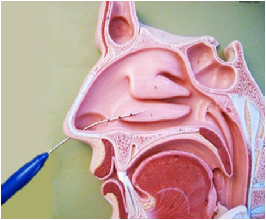
Inferior turbinate coblation using REFLEX ULTRA PTR turbinate reduction Wand
5. Diseases of the lacrimal sac (Dacryocystitis)
Lacrimal sac is small and is situated near the corner of the eye. It drain tears being produced by the tear glands to the nose via nasolacrimal duct. Infections of this sac can lead to a blockage of the tear duct causing epiphora i.e watering of eyes. This is treated surgically by endoscopic dacryocystorhinostomy (DCR) in which an opening is made in the sac through the nasal cavity. Medtronic High Speed Curved DCR bur is used to drill the bone and expose the lacrimal sac. Crawford Tubes (DCR Stent tubes) are placed routinely to prevent re-stenosis..
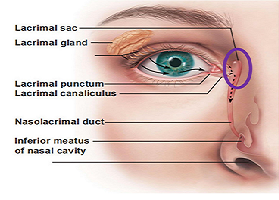
Anatomy of the lacrimal system
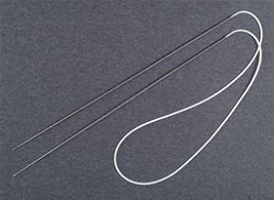
Crawford stent tubes used in DCR Surgery
6. External Nasal Deformity and FRACTURE NASAL BONE
External nasal deformities can be corrected surgically by rhinoplasty. Closed nasal reduction can be perform for fracture of the nasal bones within 2 weeks of injury. .
7. Pituitary tumors
We are also involved with nasal corridor to reach pituitary tumors. We perform endoscopic transnasal transsphenoidal approach to the pituitary to help our neurosurgery colleagues to remove tumors in the pituitary gland.
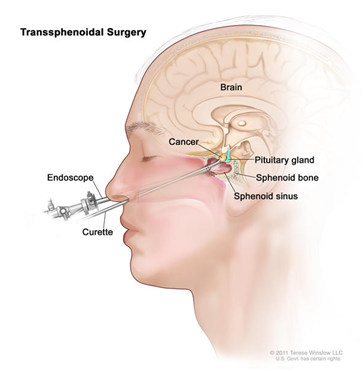
Trans-sphenoid Pituitary Surgery
